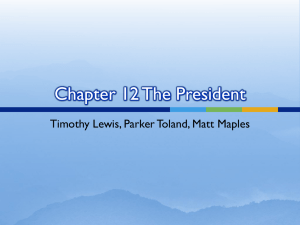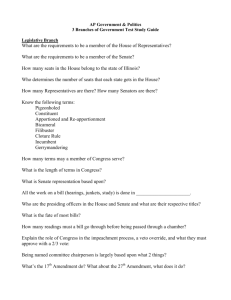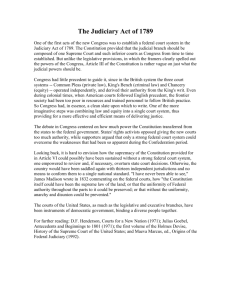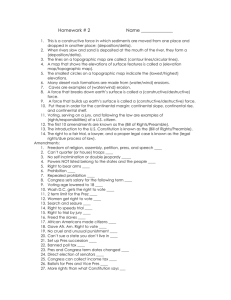MS Word Format
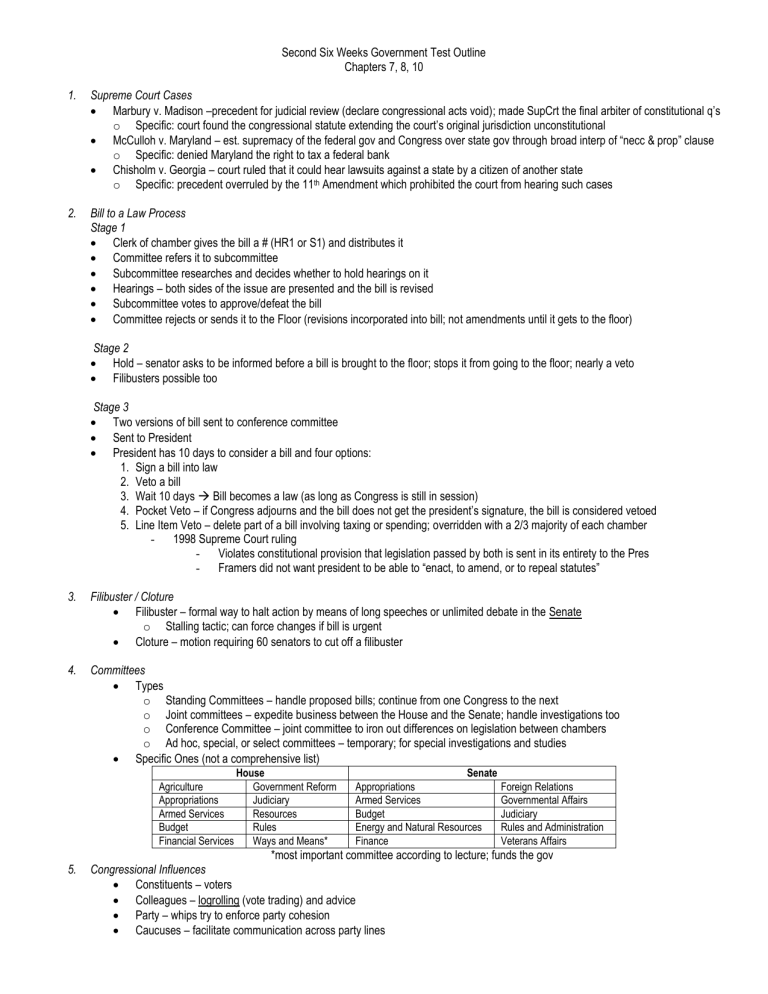
Second Six Weeks Government Test Outline
Chapters 7, 8, 10
1.
Supreme Court Cases
Marbury v. Madison –precedent for judicial review (declare congressional acts void); made SupCrt the final arbiter of constitutional q’s o Specific: court found the congressional statute extending the court’s original jurisdiction unconstitutional
McCulloh v. Maryland – est. supremacy of the federal gov and Congress over state gov through broad interp of “necc & prop” clause
o Specific: denied Maryland the right to tax a federal bank
Chisholm v. Georgia – court ruled that it could hear lawsuits against a state by a citizen of another state o Specific: precedent overruled by the 11 th Amendment which prohibited the court from hearing such cases
2.
Bill to a Law Process
Stage 1
Clerk of chamber gives the bill a # (HR1 or S1) and distributes it
Committee refers it to subcommittee
Subcommittee researches and decides whether to hold hearings on it
Hearings – both sides of the issue are presented and the bill is revised
Subcommittee votes to approve/defeat the bill
Committee rejects or sends it to the Floor (revisions incorporated into bill; not amendments until it gets to the floor)
Stage 2
Hold – senator asks to be informed before a bill is brought to the floor; stops it from going to the floor; nearly a veto
Filibusters possible too
Stage 3
Two versions of bill sent to conference committee
Sent to President
President has 10 days to consider a bill and four options:
1.
Sign a bill into law
2.
Veto a bill
3.
Wait 10 days Bill becomes a law (as long as Congress is still in session)
4.
Pocket Veto – if Congress adjourns and the bill does not get the president’s signature, the bill is considered vetoed
5.
Line Item Veto – delete part of a bill involving taxing or spending; overridden with a 2/3 majority of each chamber
-
1998 Supreme Court ruling
-
Violates constitutional provision that legislation passed by both is sent in its entirety to the Pres
Framers did not want president to be able to “enact, to amend, or to repeal statutes”
3.
Filibuster / Cloture
Filibuster – formal way to halt action by means of long speeches or unlimited debate in the Senate o Stalling tactic; can force changes if bill is urgent
Cloture – motion requiring 60 senators to cut off a filibuster
4.
Committees
Types o Standing Committees – handle proposed bills; continue from one Congress to the next o Joint committees – expedite business between the House and the Senate; handle investigations too o Conference Committee – joint committee to iron out differences on legislation between chambers o Ad hoc, special, or select committees – temporary; for special investigations and studies
Specific Ones (not a comprehensive list)
Agriculture
Appropriations
Armed Services
House
Government Reform Appropriations
Judiciary
Resources
Armed Services
Budget
Senate
Foreign Relations
Governmental Affairs
Judiciary
Budget Rules
Financial Services Ways and Means*
Energy and Natural Resources Rules and Administration
Finance Veterans Affairs
5.
Congressional Influences
Constituents – voters
*most important committee according to lecture; funds the gov
Colleagues – logrolling (vote trading) and advice
Party – whips try to enforce party cohesion
Caucuses – facilitate communication across party lines
Interest Groups / Lobbyists – provide extra info, campaign contributions, etc
Political Action Committee – source of majority of campaign money
Staff and Support Agencies – brief congressman on bills, etc
6.
Congressional Oversight
Congressional Budget Office – analyzes Pres budget and spending programs; provides cost estimates on proposed policies
Congressional Research Service – creates nonpartisan studies of public issues for congress
General Accounting Office – audits the executive branch (also sets accounting standards and does studies)
7.
Leadership (Senate Majority Leader, etc)
Speaker of the House Hastert
Secretary of the Navy England
President of the Senate Cheney
S. Minority Leader Daschle
S. Minority Whip Reid
H. Minority Leader Pelosi
CNO ADM Clark
S. Majority Leader Frist
S. Majority Whip McConnell
H. Majority Leader Delay
H. Minority Whip Hoyer
Sec State Powell
Natl Sec Advisor Rice
Sec Def Rumsfeld
H. Majority Whip Blunt
8.
Congressman Approaches
Chairman, JCS Myers
Trustee – makes what he believes to be the best decision
Delegate – vote the way their constituents want
Politico – acts as a trustee and delegate
Attorney General Ashcroft
Sec Homeland Sec Ridge
Sup Crt Justices Rehnquist (chief), Stevens,
O’Connor, Scalia, Kennedy, Souter, Ginsburg,
Breyer
9.
Presidential Limitations
War Powers Act of 1973 – doesn’t give anything; limits his power … the president is limited in the deployment of troops overseas to a 60 day period in peacetime unless Congress specifically gives its approval for a longer period.
22 nd Amendment – 2 terms or 10 years max
25 th Amendment – allows the VP and cabinet to remove the pres if they deem him unfit to perform his duties
10.
Presidential Power Abuse (accepted)
Lincoln o Suspends writ of habeas corpus and blockades south without Congressional approval o Sets precedent for Presidential power in times of national crisis
Washington o Whiskey Rebellion – supremacy of federal power (also precedent for pres power) o Jay Treaty – GW presents the treaty to Congress and says they can only approve or disapprove it and not edit it (treaty established trade with Britain with some concessions) o Declared neutrality in the war between England and France; not explicit power, but became precedent (“inherent power”)
Jefferson – Louisiana Purchase; stretches power to allow pres to act in the country’s best interests
Roosevelt – Panama Canal; pushes bills into and through Congress
FDR – New Deal
11.
Stewardship Theory vs. Taftian Theory
Stewardship Theory – pres has the duty and responsibility to execute laws and anything else in the country’s best interests
Taftian Theory – strict constitutionalist
12.
Congressionalist vs. Presidentialist
Congressionalist – the president has no power in policy creation
Presidentialist – the president has power and right in policy creation
13.
Judicial Act of 1789
Established the three-tiered structure of the federal court system (did not setup Supreme Court) o Federal District Courts Circuit Courts (Court of Appeals today) Supreme Court o Supreme Court of 6 (chief justice + 5)
14.
Court Types
Article 3 Court or Constitutional Court – one of three courts setup by the Constitution
Legislative Court – setup by Congress; special purpose, not lifetime appointments usually (Ex: Court of Military Appeals)
Three-tier system: Supreme Court US Court of Appeals US District Courts
15.
Latin Terms
stare decisis “let the decision stand” – reliance on past court decisions to make new ones; not always followed
in forma pauperis “as a poor person – allow a poor or jailed person to appeal a case to the Court; avoids expensive filings
certiorari (“to be informed”), writ of – request for SupCrt to review records of an inferior court; granted according to the Rule of Four
amicus curiae (“friend of the court”) – third party to a lawsuit who files a legal brief to influence the Court
pro bono (“no fee”) – those proceeding in forma pauperis are represented by an expert lawyer at no cost
16.
Rule of Four
If 4+ justices want to hear a case, it is heard
Court controls its caseload unlike other courts
17.
Opinions
Majority Opinion – reflects views of a majority; justifies the decision legally which becomes precedent
Concurring Opinion – agrees with the outcome but disagrees with the legal reasoning
Plurality Opinion – by 3 or 4 justices that voted in the majority; agree with decision, but not legal reasoning
Dissenting Opinion – disagree with the decision
Per Curiam Opinion – unsigned opinion
18.
Judicial Restraint and Activism
Judicial Restraint – courts should allow other branches’ decisions to stand regardless of a judge’s principles o Argue judges should be strict constructions (Example of restraint failure: Roe v. Wade)
Judicial Activism – judges should use their power broadly to further justice to protect liberties and minorities o Activists believe judges should use power broadly to further justice (Ex: Brown v. Board of Education)
19.
Extra-Legal Factors
Behavioral Characteristics – social background, religion, education, past political / legal careers, political party, etc.
Ideology – conservative or liberal
Attitudinal / Strategic Models – personal preferences toward issues of public policy
Public Opinion
20.
When the Laws Were Silent by Rehnquist (Brattebo #8)
Case Justification o Hirabayashi – court only addressed the curfew issue as his sentences ran concurrently o Korematsu –court upheld relocation o Endo – sued for being confined and won
Problem: it was done to natural born Nisei as well as immigrants
21.
Home Style by Fenno (#24) – presentation of self key to earning voting leeway with constituency
22.
The Web of Politics by Davis (#25)
Increased info
Increased ability to write Congressman
(led to by the last two) hs the ability to bring Americans into the process but … o Those who are politically uninterested will not suddenly become interested
23.
In Praise of Pork – Ellwood and Patashnik (#29)
Pork is a prerequisite for real, significant budget cuts
Pork makes unattractive but necessary bills appealing
24.
Presidential Power and the Modern Presidents – Schlesinger (#33)
Pres power grow via foreign policy (imperial Pres from post WWII until Nixon)
Cuban Missile Crisis is proof of an Imperial Presidency under Kennedy o Acute emergency that required a unilateral executive decision o Should be an exception but instead became a rule because it fulfilled:
Romantic ideal of a strong Presidency
Prophecy of a split-second nuclear-age Presidential decision
Nixon – did not have the country in mind and was removed for his abuse of power (Watergate)
25.
The Paradoxes of the American Presidency by Cronin and Genovese (#34)
1. Americans demand a powerful leader but are suspicious of centralized leadership
o Praise successful military initiatives but insist more work with Congress when they fail o Recognize need for secrecy but hate being left in the dark
2. Want a “common person” and also the uncommon visionary
3. Want a compassionate president but admire the ruthless pres
4. Admire “above politics” approach but pres is one of the most political offices
5. Want unity but the pres must take controversial stands at times
6. Lead and follow
7. Want a self-confident leader but are suspicious of infallible leaders
8. What it takes to become Pres is not necessarily what is needed to govern
9. Pres is sometimes too strong and sometimes too weak
26.
The Federalist #78 by Hamilton – why independent judiciary
Concerns addressed by lifetime appointment o Judiciary being consumed by another branch o Protection of minorities
Good: some issues are not best addressed by the majority
Bad: not directly elected
In the end the people have the power of amendments over the judiciary
27.
The Democratic Character of Judicial Review by Rostow (#44)
Judicial review keeps the exec and legis branches in check
Some phases of American life should be beyond the reach of any majority, save an amendment
28.
Storm Center by O’Brien (#45) – how to deal with public opinion
Supreme Court must strategize to maintain a good public appearance; it’s decisions are not self-executing
Enforcement requires the cooperation of all branches
Landmark Case / Example: Brown v. Board of Education o Case put off to wait for the right time o Consolidated case to provide national coverage o “All deliberate speed” not mandated until a year after the decision
Other Topics Not on the Review (but highlighted during class)
29.
Focus of Congress
House more domestically focused
Senate more internationally focused
30.
House Rules Committee – regulates the presentation of bills to the House
Can limit debate length, amendments allowed, vote time, date
Closed, Open, or Modified Rules
31.
Other Court Cases
Brennan – court should avoid making policy
Roe v. Wade – ruled on right of privacy
Lawrence v. Texas (gay rights) – not a ruling on gay rights but on privacy but leads to policy
Note: Court tries to rule on the narrowest issue so that the people can form the policy
